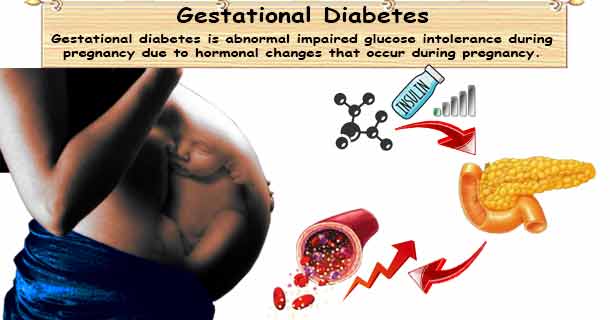The overall prevalence of gestational diabetes was 13.2%. The prevalence increased with age, from 8% to 26% in women aged 45 or older.
Therefore, it is necessary to diagnose; early diagnosis is always good for both mother and baby.
What is Gestational diabetes?
GDM is characterized as any degree of glucose intolerance onset first during pregnancy’.
Pregnant women who never had diabetes before but develop high blood glucose levels during pregnancy is diagnosed as having gestational diabetes.
Out of every 100 pregnant women in the United States, 3 to 8 get gestational diabetes.
Therefore, it is necessary to diagnose; early diagnosis is always good for both mother and baby.
Diabetes onset age is declining and the childbearing age is increasing, so it is not uncommon for women to have undiagnosed diabetes while pregnant. Thus it is important that all pregnant women should be tested both early in the pregnancy (to rule out diabetes), also later in the 2nd and 3rd trimesters (to detect GDM).
In studies, the cumulative incidence of diabetes ranged from 2.6% to over 70% that examined women 6 weeks postpartum to 28 years postpartum.
Worldwide one in 10 pregnancies is associated with diabetes, out of which 90% is gestational diabetes. Undiagnosed or improperly treated gestational diabetes can lead to maternal & fetal complications. Additionally, women with gestational diabetes and their child’s are at increased risk of developing type 2 diabetes later in life.
Maternal risks of gestational diabetes are an infection, prolonged labor, obstructed labor, cesarean section, uterine atony, postpartum hemorrhage, polyhydramnios, pre-eclampsia, and progression of retinopathy.
Fetal risks of gestational diabetes are spontaneous abortion, intrauterine death, stillbirth, congenital malformation, shoulder dystocia, birth injuries, neonatal hypoglycemia, and infant respiratory distress syndrome.
Women with gestational diabetes and their children are at increased risk for type 2 diabetes and metabolic abnormalities in the future.
Women with a history of gestational diabetes and their children are at high risk for developing diabetes. Children exposed to maternal diabetes are at higher risk for obesity and diabetes compared to their unexposed to maternal diabetes siblings.

